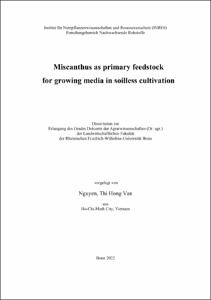Nguyen, Thi Hong Van: Miscanthus as primary feedstock for growing media in soilless cultivation. - Bonn, 2022. - Dissertation, Rheinische Friedrich-Wilhelms-Universität Bonn.
Online-Ausgabe in bonndoc: https://nbn-resolving.org/urn:nbn:de:hbz:5-66670
Online-Ausgabe in bonndoc: https://nbn-resolving.org/urn:nbn:de:hbz:5-66670
@phdthesis{handle:20.500.11811/9859,
urn: https://nbn-resolving.org/urn:nbn:de:hbz:5-66670,
author = {{Thi Hong Van Nguyen}},
title = {Miscanthus as primary feedstock for growing media in soilless cultivation},
school = {Rheinische Friedrich-Wilhelms-Universität Bonn},
year = 2022,
month = jun,
note = {Dry biomass of miscanthus crop (Miscanthus spp.) is a promising feedstock for soilless substrates in the temperate regions because of its high biomass production under low-input and ecosystem services. The objectives of this PhD work were (i) to evaluate potential supply capacity of miscanthus feedstock, opportunities and challenges when developing miscanthus into a commercial substrate, and (ii) to optimize substrate performance including increasing water holding capacity, manipulating substrate pH within the optimal range for greenhouse crops and reducing nitrogen (N) immobilization, using the “stand-alone substrate” approach.
The first objective is presented in chapter 2 as a literature review. Given potential large land available for energy crops and relatively small market for miscanthus in Europe, potential supply capacity of miscanthus was estimated to be large with less intense competition for the feedstock from other industrial activities. In chapter 3, miscanthus performance as growbag substrate for soilless cultivation of tomatoes under practical conditions. The treatments included miscanthus genotypes, substrate processing and substrate amendment with calcium nitrate (Ca(NO3)2) or elemental sulfur (S0). Results showed that all miscanthus treatments did not reduce substrate pH nor increase nitrate concentration in root-zone solution compared to those in stone wool and coir. Plants in all miscanthus substrates produced similar fruit yield to those in stone wool, but lower than those in coir. Blossom-end rot (BER) fruit mainly caused yield loss, which were lowest for coir and highest for stone wool, with miscanthus intermediate. In chapter 4, the effects of primary mechanical processing on substrate morphology, hydrological properties, pH and N immobilization were investigated. Mechanical processing altered substrate particle size and shape and consequently changed substrate water holding capacity and wettability, but hardly changed substrate pH and N immobilization. To enhance nutrient availability in miscanthus substrate, further studies should focus not only on increasing nitrate concentration, but also on increasing calcium and reducing ammonium, potassium and phosphorus concentration in substrate solution at cultivation. In chapter 5, the effects of washing and steaming pretreatments on reducing N immobilization in miscanthus substrate were assessed. Washing and steaming treatments did not reduce N immobilization in miscanthus. Steaming without pretreatment showed mild negative effect as delayed germination rate of Chinese cabbage and short lateral root length. However, washing could be a promising treatment as substrate solution showed higher calcium and lower ammonium, potassium and phosphorus concentration. In summary, the investigations showed that miscanthus is a promising primary feedstock for soilless cultivation in horticultural production. The approach to use miscanthus as “stand-alone” substrate showed clearly how substrate properties could be modified to optimize its performance.},
url = {https://hdl.handle.net/20.500.11811/9859}
}
urn: https://nbn-resolving.org/urn:nbn:de:hbz:5-66670,
author = {{Thi Hong Van Nguyen}},
title = {Miscanthus as primary feedstock for growing media in soilless cultivation},
school = {Rheinische Friedrich-Wilhelms-Universität Bonn},
year = 2022,
month = jun,
note = {Dry biomass of miscanthus crop (Miscanthus spp.) is a promising feedstock for soilless substrates in the temperate regions because of its high biomass production under low-input and ecosystem services. The objectives of this PhD work were (i) to evaluate potential supply capacity of miscanthus feedstock, opportunities and challenges when developing miscanthus into a commercial substrate, and (ii) to optimize substrate performance including increasing water holding capacity, manipulating substrate pH within the optimal range for greenhouse crops and reducing nitrogen (N) immobilization, using the “stand-alone substrate” approach.
The first objective is presented in chapter 2 as a literature review. Given potential large land available for energy crops and relatively small market for miscanthus in Europe, potential supply capacity of miscanthus was estimated to be large with less intense competition for the feedstock from other industrial activities. In chapter 3, miscanthus performance as growbag substrate for soilless cultivation of tomatoes under practical conditions. The treatments included miscanthus genotypes, substrate processing and substrate amendment with calcium nitrate (Ca(NO3)2) or elemental sulfur (S0). Results showed that all miscanthus treatments did not reduce substrate pH nor increase nitrate concentration in root-zone solution compared to those in stone wool and coir. Plants in all miscanthus substrates produced similar fruit yield to those in stone wool, but lower than those in coir. Blossom-end rot (BER) fruit mainly caused yield loss, which were lowest for coir and highest for stone wool, with miscanthus intermediate. In chapter 4, the effects of primary mechanical processing on substrate morphology, hydrological properties, pH and N immobilization were investigated. Mechanical processing altered substrate particle size and shape and consequently changed substrate water holding capacity and wettability, but hardly changed substrate pH and N immobilization. To enhance nutrient availability in miscanthus substrate, further studies should focus not only on increasing nitrate concentration, but also on increasing calcium and reducing ammonium, potassium and phosphorus concentration in substrate solution at cultivation. In chapter 5, the effects of washing and steaming pretreatments on reducing N immobilization in miscanthus substrate were assessed. Washing and steaming treatments did not reduce N immobilization in miscanthus. Steaming without pretreatment showed mild negative effect as delayed germination rate of Chinese cabbage and short lateral root length. However, washing could be a promising treatment as substrate solution showed higher calcium and lower ammonium, potassium and phosphorus concentration. In summary, the investigations showed that miscanthus is a promising primary feedstock for soilless cultivation in horticultural production. The approach to use miscanthus as “stand-alone” substrate showed clearly how substrate properties could be modified to optimize its performance.},
url = {https://hdl.handle.net/20.500.11811/9859}
}






